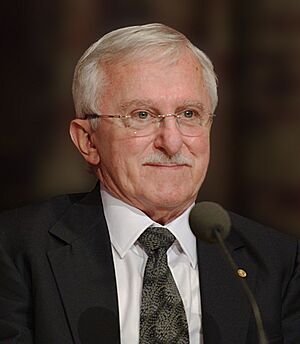Paul L. Modrich facts for kids
Quick facts for kids
Paul Modrich
|
|
|---|---|

Paul L. Modrich in December 2015
|
|
| Born |
Paul Lawrence Modrich
June 13, 1946 Raton, New Mexico, U.S.
|
| Alma mater | MIT Stanford University (PhD) |
| Known for | Clarification of cellular resistance to carcinogens Modrich–Lehman unit |
| Awards |
|
| Scientific career | |
| Fields | DNA mismatch repair |
| Institutions | |
| Thesis | Structure, mechanism and biological role of E. coli DNA ligase (1973) |
| Doctoral advisor | Robert Lehman |
Paul Lawrence Modrich (born June 13, 1946) is an American biochemist. He is a professor of Biochemistry at Duke University and a researcher at the Howard Hughes Medical Institute. He is famous for his work on how cells fix mistakes in their DNA. Modrich won the Nobel Prize in Chemistry in 2015, sharing it with Aziz Sancar and Tomas Lindahl.
Contents
Early Life and Education
Paul Modrich was born on June 13, 1946, in Raton, New Mexico. His parents were Laurence and Margaret Modrich. He has a younger brother named Dave. His father was a biology teacher and a coach at Raton High School, where Paul graduated in 1964.
Modrich's family background is quite diverse. His father's side has Croatian and Montenegrin roots. His grandparents came to the United States from coastal Croatia in the late 1800s. His mother's family has German and Scottish heritage.
In 1980, Modrich married Vickers Burdett, who is also a scientist.
College and Advanced Studies
Paul Modrich went to the Massachusetts Institute of Technology (MIT) and earned his bachelor's degree in 1968. He then continued his studies at Stanford University, where he received his PhD in 1973. After that, he did more research for a year at Harvard Medical School from 1973 to 1974.
Important Research
In 1974, Modrich started working as a professor in the chemistry department at the University of California, Berkeley. Two years later, in 1976, he joined the faculty at Duke University. Since 1995, he has also been a researcher with the Howard Hughes Medical Institute.
His main research focuses on something called "strand-directed mismatch repair." This is a special process that cells use to fix errors in their DNA. Think of it like a spell-checker or copyeditor for DNA. When DNA is copied, sometimes tiny mistakes happen. Modrich's lab showed how this repair system acts like a copyeditor to prevent these errors from causing problems.
Another scientist, Matthew Meselson, had suggested that cells might have a way to recognize these mistakes. Modrich then did experiments to study how this mismatch repair works in bacteria called E. coli. Later, his team looked for the proteins that help with mismatch repair in human cells. This research is very important because it helps us understand how cells stay healthy and how they protect themselves from things that can cause diseases.
Awards and Recognition
Paul Modrich has received many important awards for his scientific work. Some of these include:
- 1983: Pfizer Award in Enzyme Chemistry
- 1996: General Motors Charles S. Mott Prize in Cancer Research
- 1998: Robert J. and Claire Pasarow Foundation Medical Research Award for cancer research
- 2000: Feodor Lynen Medal
- 2005: American Cancer Society Medal of Honor
- 2015: Nobel Prize in Chemistry
- 2016: Arthur Kornberg and Paul Berg Lifetime Achievement Award in Biomedical Sciences
Modrich is also a member of several important scientific groups, including the American Academy of Arts and Sciences, the National Academy of Medicine, and the National Academy of Sciences.
See also
 In Spanish: Paul L. Modrich para niños
In Spanish: Paul L. Modrich para niños

